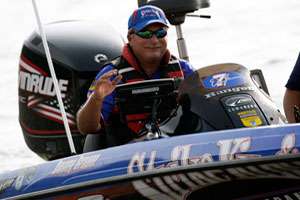
Denny Brauer, 1987 Toyota Tundra Bassmaster Angler of the Year and 1998 Bassmaster Classic champion, knows that the summer-fall transition period can prove difficult but he has a few tips to help you overcome the challenge.
Brauer says the most important thing to focus on during the late summer transition is the forage. In most cases, that means shad. The forage is the one constant on the lake as the water is beginning to turn over and the fish are moving daily trying to find a routine to settle into.
"The transition can be tough. The honeyhole scenario from summer is over because it's been way over-pressured," he says. "This is an exciting and frustrating time of year to be fishing. A lot of guys need to make a change in the water they are targeting, even from a week ago.
"Some fish are still in full summer pattern, and some are in full fall, but most will be in that transition phase, and that means chasing bait," he says. "For the most part, they're moving shallow, so you want to follow them into the creeks."
Brauer favors shad imitating baits like square-billed crankbaits, but will also lean heavily on a 1/2-ounce Strike King Premier Plus spinnerbait in Sexy Shad. Brauer works his spinnerbait differently this time of year to mimic the baitfish activity.
"I fish it high in the water column rather than slow rolling it like in summer," he says. "Usually I keep it within the top 2 feet of the water. When the water is clearer, I move it faster and keep it higher so they don't get a good look at it. In dirty water, I like Indiana or Colorado blades that thump more to help the bass find it."
Brauer opts for a 7-foot, 3-inch American Rodsmiths rod for his spinnerbaiting. The fast tip allows him to use it as a worming rod as well. He likes the increased casting distance and hook setting power a long rod offers. An Ardent XS1000 spooled with 20-pound-test Seaguar fluorocarbon does the casting and retrieving.
A spinnerbait allows Brauer to cover lots of water while searching for baitfish. He starts firing at isolated targets such as stumps or logs or any place a bass may use to ambush prey. If you don't have any isolated targets, Brauer says to watch for shad. If you see any, you need to run a bait through that area.
"You can't sit and pick a spot apart now, you need to move. The fish are scattered around and are relating to the bait," he says. "You need to cover a lot of water, but you need to cover the right type of water, too."
By that he means shallow water. Flats on the main lake and the inside bends of creeks that lead to the flats are his favorites.
"Come fall, you can just pick up a buzzbait and have things start working for you, but now it's tough. The bait is the most important thing to find. If you're totally lost, head to main lake and secondary points and you can probably salvage a day by picking off a few fish that are still in summer mode," he says.




